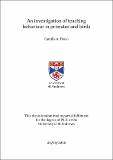Files in this item
An investigation of teaching behaviour in primates and birds
Item metadata
| dc.contributor.advisor | Laland, Kevin N. | |
| dc.contributor.advisor | Hoppitt, William | |
| dc.contributor.author | Troisi, Camille A. | |
| dc.coverage.spatial | xiii, 349 p. | en_US |
| dc.date.accessioned | 2017-11-06T15:45:13Z | |
| dc.date.available | 2017-11-06T15:45:13Z | |
| dc.date.issued | 2017 | |
| dc.identifier.uri | https://hdl.handle.net/10023/12008 | |
| dc.description.abstract | Many animals socially learn, but very few do so through teaching, where an individual modifies its behaviour in order to facilitate learning for another in individual. Teaching behaviour is costly, but can confer numerous advantages, such as high fidelity transmission of information or an increase in the rate of social learning. In many putative cases of teaching, it is not known whether the pupil learns from the modified behaviour. This thesis addresses this issue in three cases of potential teaching behaviour. In particular, it investigates whether the role of food transfers in wild golden lion tamarins is to teach which foods are good to eat (Chapter 5). There was little evidence that novel foods were transferred more than familiar foods, and this was not due to the juveniles attempting to obtain novel foods more than familiar ones, or by adults discarding novel foods more than familiar ones. Transfers were however more successful when donors had previously ingested the food type transferred. Successful food transfers also had a positive correlation with foraging choices once juveniles were older, suggesting they learned from food transfers. In golden lion tamarins, this thesis also examined whether juveniles learned from food-offering calls which substrates were good to forage on (Chapter 6). Juveniles that experienced playback of food-offering calls ate more on a novel substrate, than juveniles that did not experience those playbacks, both immediately as the calls were being played, and in the long term, six months after the playbacks. This suggests that juveniles learned from the playbacks. Finally, this thesis attempted to replicate previous findings showing that hens modify their behaviour when chicks feed from seemingly unpalatable food, and explored whether chicks learned what food to eat based on the maternal display (Chapter 7). The experiment failed to find evidence for teaching behaviour, but results were not inconsistent with previous findings. Moreover, there was little evidence that chicks learned from their mother, quite to the contrary, hens seemed to acquire their foraging decisions based on their chicks’ choices. | en_US |
| dc.description.sponsorship | "The work presented in this thesis was supported by an ERC Advanced Grant and John templeton Foundation Grant to Kevin Laland." -- Acknowledgements | en |
| dc.language.iso | en | en_US |
| dc.publisher | University of St Andrews | |
| dc.rights | Attribution-NonCommercial-NoDerivatives 4.0 International | * |
| dc.rights.uri | http://creativecommons.org/licenses/by-nc-nd/4.0/ | * |
| dc.subject | Teaching | en_US |
| dc.subject | Social learning | en_US |
| dc.subject | Foraging | en_US |
| dc.subject | Golden lion tamarin | en_US |
| dc.subject | Domestic fowl | en_US |
| dc.subject.lcc | QL785.T77 | |
| dc.subject.lcsh | Animal intelligence. | en |
| dc.subject.lcsh | Cognition in animals. | en |
| dc.subject.lcsh | Learning in animals. | en |
| dc.title | An investigation of teaching behaviour in primates and birds | en_US |
| dc.type | Thesis | en_US |
| dc.contributor.sponsor | European Research Council (ERC) | en_US |
| dc.contributor.sponsor | Templeton Foundation | en_US |
| dc.type.qualificationlevel | Doctoral | en_US |
| dc.type.qualificationname | PhD Doctor of Philosophy | en_US |
| dc.publisher.institution | The University of St Andrews | en_US |
The following licence files are associated with this item:
This item appears in the following Collection(s)
Except where otherwise noted within the work, this item's licence for re-use is described as Attribution-NonCommercial-NoDerivatives 4.0 International
Items in the St Andrews Research Repository are protected by copyright, with all rights reserved, unless otherwise indicated.


